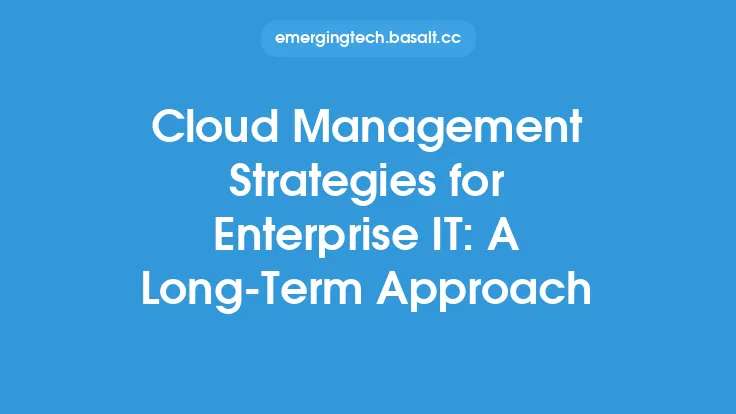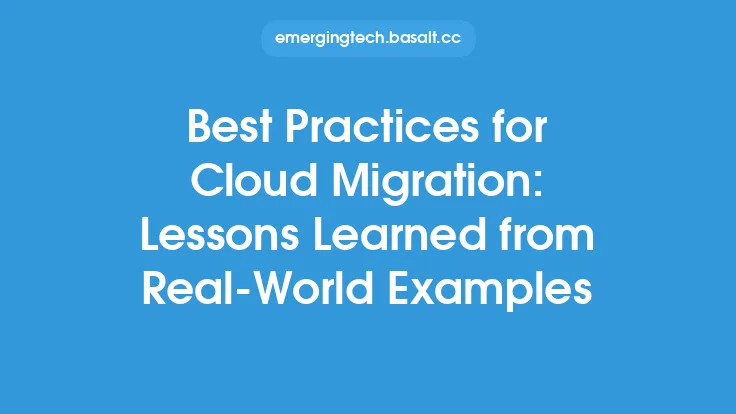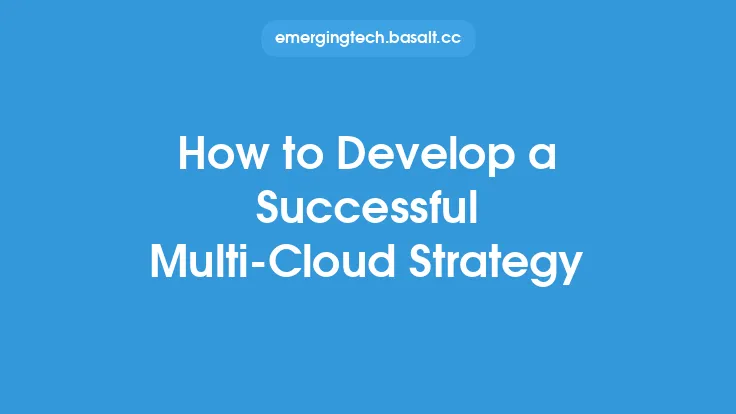As organizations continue to adopt cloud computing, they are increasingly looking to multi-cloud strategies to meet their evolving needs. A well-planned multi-cloud roadmap is essential for long-term success, enabling businesses to leverage the strengths of different cloud providers, mitigate risks, and optimize their IT infrastructure. In this article, we will delve into the key considerations and best practices for building a multi-cloud roadmap, exploring the technical and strategic aspects of this approach.
Introduction to Multi-Cloud Roadmapping
A multi-cloud roadmap is a comprehensive plan that outlines an organization's cloud strategy, including the deployment of applications and services across multiple cloud providers. This roadmap should align with the company's overall business objectives, taking into account factors such as scalability, security, compliance, and cost optimization. By developing a multi-cloud roadmap, organizations can ensure that their cloud infrastructure is flexible, resilient, and capable of supporting their growth and innovation goals.
Assessing Current State and Future Requirements
The first step in building a multi-cloud roadmap is to assess the organization's current state and future requirements. This involves evaluating the existing IT infrastructure, applications, and services, as well as identifying the business objectives and outcomes that the multi-cloud strategy is intended to support. Key considerations include:
- Application portfolio: Which applications are currently deployed in the cloud, and which ones are candidates for migration to a multi-cloud environment?
- Cloud provider landscape: Which cloud providers are currently being used, and which ones are being considered for future deployment?
- Security and compliance: What are the security and compliance requirements for the organization, and how will they be addressed in a multi-cloud environment?
- Cost and budget: What is the budget for cloud services, and how will costs be optimized and managed across multiple cloud providers?
Defining the Multi-Cloud Architecture
With a clear understanding of the organization's current state and future requirements, the next step is to define the multi-cloud architecture. This involves designing a framework that integrates multiple cloud providers, ensuring seamless communication and data exchange between them. Key considerations include:
- Cloud service models: Which cloud service models (IaaS, PaaS, SaaS) will be used, and how will they be integrated across multiple cloud providers?
- Cloud deployment models: Which cloud deployment models (public, private, hybrid) will be used, and how will they be integrated with on-premises infrastructure?
- Network and security architecture: How will network and security architectures be designed to support multiple cloud providers, ensuring secure and reliable communication between them?
- Data management and integration: How will data be managed and integrated across multiple cloud providers, ensuring consistency and integrity?
Selecting Cloud Providers and Services
Selecting the right cloud providers and services is critical to the success of a multi-cloud strategy. Organizations should evaluate cloud providers based on factors such as:
- Service offerings: Which cloud services (compute, storage, database, analytics) are offered by each provider, and how do they align with the organization's requirements?
- Pricing and cost models: What are the pricing and cost models for each cloud provider, and how will they impact the organization's budget?
- Security and compliance: What are the security and compliance features and capabilities of each cloud provider, and how do they align with the organization's requirements?
- Support and services: What level of support and services is offered by each cloud provider, and how will they impact the organization's ability to manage and optimize its cloud infrastructure?
Implementing and Managing the Multi-Cloud Environment
Implementing and managing a multi-cloud environment requires careful planning and execution. Organizations should consider the following best practices:
- Cloud management platforms: Using cloud management platforms (CMPs) to manage and optimize cloud resources across multiple cloud providers.
- Automation and orchestration: Using automation and orchestration tools to streamline cloud deployment, management, and optimization.
- Monitoring and analytics: Using monitoring and analytics tools to track cloud performance, security, and compliance, and to identify areas for optimization.
- Training and skills development: Providing training and skills development for IT staff to ensure they have the necessary expertise to manage and optimize the multi-cloud environment.
Ensuring Interoperability and Portability
Ensuring interoperability and portability is critical to the success of a multi-cloud strategy. Organizations should consider the following best practices:
- Open standards: Using open standards and APIs to ensure interoperability between cloud providers and services.
- Containerization: Using containerization technologies (e.g., Docker) to ensure application portability across multiple cloud providers.
- Cloud-agnostic tools: Using cloud-agnostic tools and platforms to manage and optimize cloud resources across multiple cloud providers.
- Data portability: Ensuring data portability across multiple cloud providers, using standards such as CSV, JSON, or XML.
Conclusion
Building a multi-cloud roadmap is a complex and challenging task, requiring careful planning, execution, and management. By following the best practices and considerations outlined in this article, organizations can ensure that their multi-cloud strategy is aligned with their business objectives, and that they are well-positioned for long-term success. A well-planned multi-cloud roadmap will enable organizations to leverage the strengths of different cloud providers, mitigate risks, and optimize their IT infrastructure, ultimately driving business agility, innovation, and growth.





